

TMJ Syndrome Treatment with Therapeutic Bodyworks. Treating TMJ Syndrome with Therapeutic Bodywork Briefly outlining the basis of TMJ (tempromandibular joint), and the necessary components of successfully applying therapeutic bodywork techniques to treat it, will hopefully alleviate much of the confusion about TMJ syndrome.
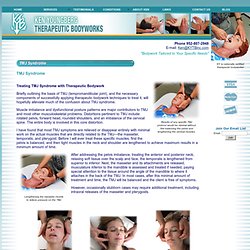
Muscle imbalance and dysfunctional posture patterns are major contributors to TMJ and most other musculoskeletal problems. Distortions pertinent to TMJ include: rotated pelvis, forward head, rounded shoulders, and an imbalance of the cervical spine. The entire body is involved in this core distortion. I have found that most TMJ symptoms are relieved or disappear entirely with minimal work on the actual muscles that are directly related to the TMJ—the masseter, temporalis, and pterygoid.
After addressing the pelvis imbalance, treating the anterior and posterior neck, relaxing soft tissue over the scalp and face, the temporalis is lengthened from superior to inferior. Technique: TMJ Mastery part 1 - Massage Therapy Canada. This is the first of a three-part series exploring principles and concepts in intra-oral applications treating TMJ dysfunction.
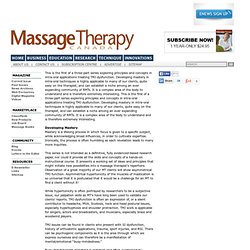
Developing mastery in intra-oral techniques is highly applicable to many of our clients, quite easy on the therapist, and can establish a niche among an ever expanding community of RMTs. It is a complex area of the body to understand and is therefore extremely interesting. This is the first of a three-part series exploring principles and concepts in intra-oral applications treating TMJ dysfunction. Developing mastery in intra-oral techniques is highly applicable to many of our clients, quite easy on the therapist, and can establish a niche among an ever expanding community of RMTs.
It is a complex area of the body to understand and is therefore extremely interesting. Developing Mastery Mastery is a lifelong process in which focus is given to a specific subject, while acknowledging broad influences, in order to cultivate expertise. Temporalis m. La Mesa Massage Therapy San Diego Therapist Angela Robertson Specials 91942. Sarasota Massage Therapy-Relaxation and Therapeutic Massage - Articles. How massage can help clients dealing with temporomandibular dysfunction.
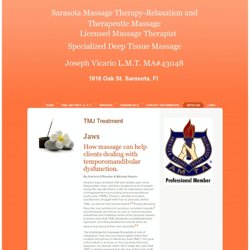
By Patricia O’Rourke & Michael Hamm Healers have wrestled with jaw-related pain since Hippocrates’ time, and they’ve gained a lot of insight along the way. But there is still an impressive amount of disagreement surrounding temporomandibular dysfunction (TMD). Doctors, dentists and other practitioners struggle with how to precisely define TMD, as well as how best to treat it. 1 , 2 Purely structural fixes like oral splints don’t produce consistent results, 3 and therapists who focus on pain or stress reduction sometimes don’t address some of the physical causes. It seems clear that TMD demands a multidisciplinary approach, and that practitioners should strive for awareness beyond their own specialty. 3 , 4 The challenge for massage therapists is one of integration: how can you meaningfully draw from multiple disciplines to effectively treat TMD? Anatomy & Pathophysiology Pieces of a Whole Possible Problem Areas.
Muscles of Facial Expression - Muscles of the Face, Head, and Neck. Diagram of the key muscles of human facial expression with interactive image for learning or revising them.
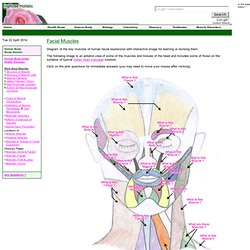
The following image is an anterior view of some of the muscles and tissues of the head and includes some of those on the syllabus of typical Indian head massage courses. Click on the pink questions for immediate answers (you may need to move your mouse after clicking). The following muscles/tissues are labelled in the diagram above. Click on the terms in pink below to view their entries in the IvyRose glossary section. These pages about the individual facial muscles include more detail about their points of origin and insertion, and also their actions. Seated Scalene Stretch - Massage Study Guide. Armpit Sniff Stretch - Massage Study Guide. Standing Neck Extensor Stretch - Massage Study Guide. Masseter Muscle: Location, Actions, and Trigger Points - Ground Up Strength. By Ground Up Strength The masseter is a jaw muscle that gets its name from the Greek work "to chew".
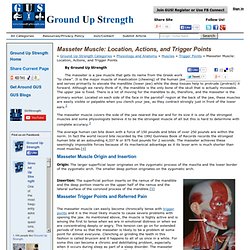
It is the major muscle of mastication (chewing) of the human jaw and serves primarily to elevate the mandible (lower jaw) while the deep tissues help to protrude (protract) it forward. Although we rarely think of it, the mandible is the only bone of the skull that is actually moveable.